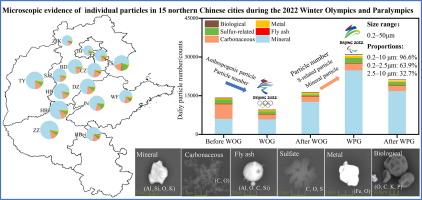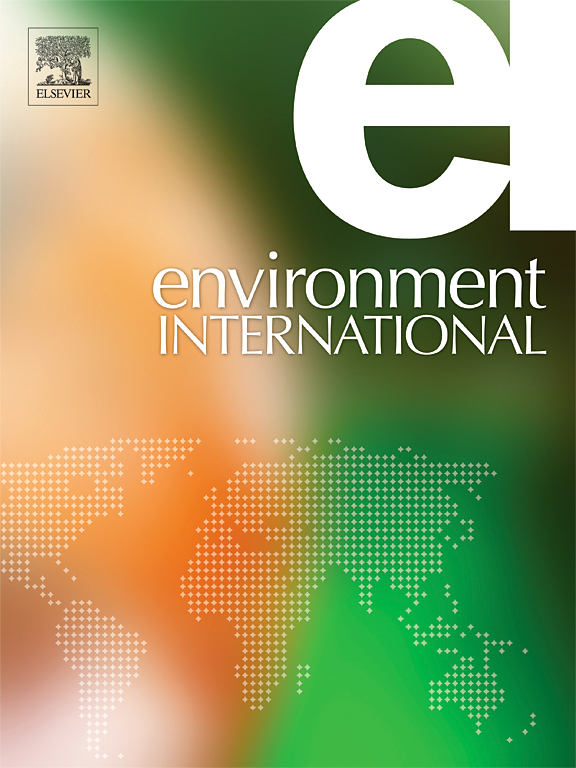2022 年冬季奥运会和残奥会期间中国北方大气颗粒物源变化对控制措施的响应:微观分析证据
IF 10.3
1区 环境科学与生态学
Q1 ENVIRONMENTAL SCIENCES
引用次数: 0
摘要
大气颗粒物的物理化学特性(包括形态和成分)与其来源和形成机制直接相关。然而,以往的研究大多局限于少数地点和少量颗粒。在这项研究中,我们采用了计算机控制的扫描电子显微镜(CCSEM)来提高测量效率,并能在多个地点进行长期观测。为了研究2022年冬奥会(WOG)和冬残奥会(WPG)举办之前、期间和之后大气颗粒物的特性和来源变化对控制措施的响应,我们在中国北方15个城市被动采集了环境颗粒物,并利用先进的计算机控制扫描电子显微镜(IntelliSEM EPAS)进行了自动分析。对颗粒数量(PN)、粒度分布、元素组成和来源的变化进行了全面分析。利用用户定义的分类规则,将 100 多万个颗粒物分为矿物颗粒、碳质颗粒、粉煤灰颗粒、硫相关颗粒、含金属颗粒、盐颗粒和生物颗粒。结果表明,WOG 期间空气质量有所改善,PN 和人为颗粒物减少,但 WPG 期间由于粗模 PN、矿物和硫相关颗粒物增加而恶化。北京和张家口的 AQI、PN 和人为颗粒物较低,而非竞争城市的人为颗粒物和硫相关颗粒物水平较高。值得注意的是,太原和石家庄在 WOG 期间表现出明显的减排效果,而保定和唐山的控制效果较差,硫相关颗粒物和人为富铁颗粒物水平较高。这项研究表明,CCSEM 能够提供颗粒物来源和行为的微观证据,为了解重大活动期间控制措施的效果提供了宝贵的见解。本文章由计算机程序翻译,如有差异,请以英文原文为准。


Source variations of atmospheric particles in response to control measures in northern China during 2022 winter olympics and paralympics: Evidence from microscopic analysis
The physicochemical properties of atmospheric particles including morphologies and composition are directly related to their sources and formation mechanisms. However, most previous studies have been limited to a few sites and small numbers of particles. In this study, we employed computer-controlled scanning electron microscopy (CCSEM) to enhance measurement efficiency and enable long-term observations across multiple sites. To investigate properties and source variations of atmospheric particles in response to control measures before, during, and after the 2022 Winter Olympic Games (WOG) and Winter Paralympic Games (WPG), ambient particles were passively collected in 15 northern Chinese cities and automatically analyzed by an advanced CCSEM (IntelliSEM EPAS). Variations in particle numbers (PN), size distribution, elemental composition, and sources were comprehensively analyzed. Over one million particles were classified into mineral, carbonaceous, fly ash, sulfur-related, metal-containing, salt, and biological particles using the user-defined classification rules. The results showed that improved air quality was witnessed during the WOG with reduced PN and anthropogenic particles, but deteriorated during the WPG due to increased coarse-mode PN, mineral, and sulfur-related particles. Beijing and Zhangjiakou exhibited lower AQI, PN, and anthropogenic particles, while non-competition cities experienced higher levels of anthropogenic and sulfur-related particles. Notably, Taiyuan and Shijiazhuang showed distinct emission reductions during the WOG, while Baoding and Tangshan demonstrated less effective control with high levels of sulfur-related and anthropogenic Fe-rich particles. This study shows the capability of CCSEM to provide microscopic evidence of particle sources and behaviors, offering valuable insights into the efficacy of control measures during major events.
求助全文
通过发布文献求助,成功后即可免费获取论文全文。
去求助
来源期刊

Environment International
环境科学-环境科学
CiteScore
21.90
自引率
3.40%
发文量
734
审稿时长
2.8 months
期刊介绍:
Environmental Health publishes manuscripts focusing on critical aspects of environmental and occupational medicine, including studies in toxicology and epidemiology, to illuminate the human health implications of exposure to environmental hazards. The journal adopts an open-access model and practices open peer review.
It caters to scientists and practitioners across all environmental science domains, directly or indirectly impacting human health and well-being. With a commitment to enhancing the prevention of environmentally-related health risks, Environmental Health serves as a public health journal for the community and scientists engaged in matters of public health significance concerning the environment.
 求助内容:
求助内容: 应助结果提醒方式:
应助结果提醒方式:


